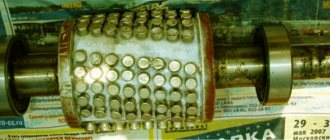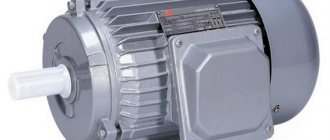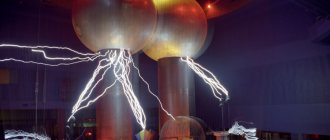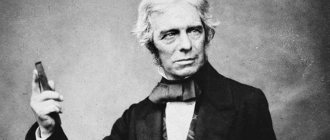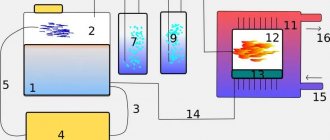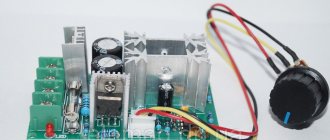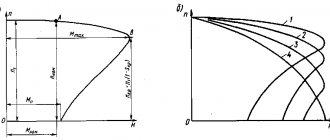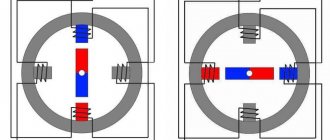To power household devices and industrial equipment, a source of electricity is required. It is possible to generate electric current in several ways. But the most promising and cost-effective today is the generation of current by electric machines. The easiest to manufacture, cheapest and most reliable in operation turned out to be an asynchronous generator, which generates the lion's share of the electricity we consume.
The use of electric machines of this type is dictated by their advantages. Asynchronous electric generators, unlike synchronous generators, provide:
- higher degree of reliability;
- long service life;
- efficiency;
- minimal maintenance costs.
These and other properties of asynchronous generators are inherent in their design.
What is an asynchronous motor
An induction motor (IM) is an electrical machine used to convert electrical energy into mechanical energy. This engine got its name due to the fact that the rotational speeds of the moving part of the engine and the magnetic field (MF) do not coincide.
- The basis of the IM is the stator and rotor. The stator is a cylinder made of electrical steel sheets.
- Its core contains special windings that must be shifted 120 degrees from each other.
- A rotor is a rotating part of an electrical machine driven by a drive or drive shaft.
The rotor is made of steel sheets. It can be of two types, phase or short-circuited, and is made in the form of a drum, disk or wheel
The operating principle of the IM is that when voltage is applied from an external source to the stationary stator windings, a mutual induction emf is induced in the rotating part of the motor and induces eddy currents. Due to eddy currents, its own EMF is generated, which forms the rotor MF.
Principle of operation
The generator produces electrical energy provided that the number of rotor revolutions is slightly higher than the synchronous speed. The simplest type produces about 1800 rpm, taking into account that its synchronous speed level becomes 1500 rpm.
Its operating principle is based on the conversion of mechanical energy into electricity. You can force the rotor to rotate and produce electricity using a strong torque. Ideally, a constant idle speed that can maintain the same speed.
All types of motors operating on intermittent current are called asynchronous. In them, the magnetic field of the stator spins faster than the field of the rotor, accordingly directing it in the direction of its movement. To change the electric motor into a functioning generator, you will need to increase the speed of the rotor so that it does not follow the magnetic field of the stator, but begins to move in the other direction.
You can get a similar result by connecting the device to the mains, a capacitor with a large capacity, or a whole group of capacitors. They charge and accumulate energy from magnetic fields. The capacitor phase has a charge that is opposite to the motor current source, which causes the rotor to slow down and the stator winding to generate current.
Types of asynchronous motors
Induction motors can vary in the number of phases used.
There are single-phase, two-phase and three-phase electric motors.
- Single-phase electric motors have one operating winding and use single-phase current. Such an engine can operate from a standard network and is the most common in its category. The disadvantage of a single-phase motor is the need for an additional winding, which provides additional rotation to start the rotor moving.
- A two-phase asynchronous motor is a little more complicated than a single-phase one; it has a phase-shifting capacitor and two windings that are opposite each other. Two-phase devices operate on alternating current.
- A three-phase IM has three working windings shifted relative to each other by 120 degrees. Stable operation in such an engine is achieved due to the MP being shifted in space. The main advantage of such a motor is its resistance to overloads, but three-phase motors have a complex system for adjusting the shaft rotation speed.
Also, asynchronous motors may differ in the type of rotor installed in them. More common in industry are induction motors with a squirrel-cage rotor (induction motor with a squirrel-cage rotor); among the advantages of such an engine are the following:
- Cheapness;
- Strength;
- High performance;
- Easy to maintain.
Asynchronous motors with a phase-type rotor are less popular, due to a number of disadvantages:
- Need for regular maintenance;
- High copper consumption;
- Complexity of design.
Method 2
You can make a homemade generator in another way. The stator has a clever design (it has a special design solution), and it is possible to adjust the output voltage. I made this type of generator with my own hands at a construction site. The engine produced 7 kW at 900 rpm. I connected the excitation winding according to a 220 V delta circuit. I started it at 1600 rpm, the capacitors were 3 to 120 uF. They were switched on by a contactor with three poles. The generator acted as a three-phase rectifier. This rectifier fed an electric drill with a 1000-watt collector, and a 2200-watt circular saw, 220 V, and a 2000-watt grinder.
I had to make a soft start system, another resistor with a shorted phase after 3 seconds.
This is not correct for motors with commutators. If you double the rotating frequency, the capacitance will also decrease.
The frequency will also increase. The tank circuit was switched off automatically so as not to use the reactivity torus and not waste fuel.
During operation, you must press the contactor stator. Three phases dismantled them as unnecessary. The reason lies in the high gap and increased field dissipation of the poles.
Special mechanisms with a double cage for the squirrel and slanted eyes for the squirrel. Still, I got 100 volts and a frequency of 30 hertz from the washing machine motor, the 15 watt lamp does not want to light up. Very weak power. It is necessary to take a stronger motor, or install more capacitors.
A generator with a squirrel-cage rotor is used under the cars. Its mechanism comes from a gearbox and a belt drive. Rotation speed 300 rpm. It is located as an additional load generator.
What is an asynchronous generator
An asynchronous generator (AG) is an asynchronous machine operating in generator mode.
The design of an asynchronous generator is very similar to an asynchronous motor, but energy conversion occurs in the opposite direction. AG converts mechanical energy (this can be wind, hydraulic, or others) into electrical energy.
The operating principle of asynchronous generators is that magnetic lines of force formed as a result of rotor rotation cross the stator windings. When a load is connected, the EMF generated in the coils leads to the appearance of current in the circuit. Below are photos of asynchronous generators:
Method 3
You can design a homemade generator, a gasoline-powered power plant.
Instead of a generator, use a 3-phase asynchronous motor of 1.5 kW at 900 rpm. The electric motor is Italian and can be connected with a triangle or a star. First, I placed the motor on a base with a DC motor and attached it to the coupling. I started turning the engine at 1100 rpm. A voltage of 250 volts appeared on the phases. I connected a 1000 watt light bulb, the voltage immediately dropped to 150 volts. This is probably due to phase imbalance. Each phase must have a separate load. Three 300-watt light bulbs will not be able to reduce the voltage to 200 volts, theoretically. You can put a larger capacitor.
The engine speed must be increased and not reduced when under load, then the power supply to the network will be constant.
Significant power is required; an autogenerator will not provide such power. If you rewind a large KAMAZ, then 220 V will not come out of it, since the magnetic circuit will be oversaturated. It was designed for 24 volts.
Today I was going to try connecting the load through a 3-phase power supply (rectifier). They turned off the lights in the garages, but it didn’t work. In the city of power engineers, the lights are systematically turned off, so it is necessary to create a source of constant power supply with electricity. There is an attachment for electric welding that is attached to the tractor. To connect an electric tool, you need a constant voltage source of 220 V. There was an idea to construct a homemade generator with your own hands, and an inverter for it, but you can’t work on batteries for long.
The electricity was recently turned on. I connected an asynchronous motor from Italy. I placed it with the chainsaw motor on the frame, twisted the shafts together, and installed a rubber coupling. I connected the coils according to a star circuit, the capacitors in a triangle, 15 μF each. When I started the motors, there was no power output. I connected a capacitor charged to the phases, and voltage appeared. The engine produced its power of 1.5 kW. At the same time, the supply voltage dropped to 240 volts; at idle it was 255 volts. The grinder operated normally at 950 watts.
I tried to increase the engine speed, but there was no excitement. After the capacitor contacts the phase, voltage appears immediately. I will try to install a different engine.
What system designs are produced abroad for power plants? On 1-phase ones, it is clear that the rotor owns the winding, there is no phase imbalance, because there is one phase. In 3-phase there is a system that allows power adjustment when motors with the highest load are connected to it. You can also connect an inverter for welding.
Over the weekend I wanted to make a homemade generator with my own hands using an asynchronous motor. A successful attempt to make a homemade generator turned out to be connecting an old engine with a cast iron housing of 1 kW and 950 rpm. The motor is excited normally, with one 40 µF capacitance. And I installed three containers and connected them with a star. This was enough to start an electric drill and grinder. I wanted it to produce voltage output on one phase. To do this, I connected three diodes, a half-bridge. The fluorescent lamps for lighting burned out, and the bags in the garage were set on fire. I will wind the transformer into three phases.
Write comments, additions to the article, maybe I missed something. Take a look at the site map, I will be glad if you find anything else useful on my site.
Advantages and disadvantages of asynchronous generators
Among all the advantages of an asynchronous generator, it is worth highlighting:
- Ease of maintenance;
- Low cost;
- Low sensitivity to short circuit (short circuit);
Despite this, asynchronous generators are not very popular, the reason for this is a number of disadvantages:
- Unreliable operation under high load;
- Dependence on electrical network parameters;
- Dependence on the active-inductive nature of the load.
Applications
1200 Amp Outdoor Mount Generator Connection Panel
Motor generators are used to provide electrical power in areas where utility power (central station) is not available or where power is only needed temporarily. Small generators are sometimes used to provide power to power tools on construction sites. Trailer-mounted generators provide temporary lighting installations, sound reinforcement systems, amusement rides, etc. You can use a power chart to calculate the estimated power consumption for different types of equipment to determine how many watts are needed for a portable generator.[3]
Trailer-mounted generators or mobile generators, diesel generators are also used for emergencies or backup when either a backup system is required or a generator is not on site. To make the connection faster and safer, the insertion panel
often installed near switchgear in a building that contains connectors such as cam locks. The connection panel may also contain a phase rotation indicator (for 3-phase systems) and a circuit breaker. Camlock connectors are rated from 400A to 480V and are used with 4/0 W type cable connecting the generator. Terminal panel designs are common in 200 and 3000 amp applications.
Stand-by electric generators are permanently installed and are used to provide immediate power to critical loads during temporary power outages. Hospitals, communications facilities, data centers, sewage pumping stations and many other critical facilities are equipped with backup power generators. Some backup power generators can automatically detect loss of power from the grid, start the engine, and run on fuel from the gas pipeline. , detects when power is restored to the grid and then shuts down without human intervention.[4]
Private generators are especially popular in areas where power supply is unreliable or unavailable. Trailer-mounted generators can be towed into disaster areas where power is temporarily out.
Asynchronous generator from an asynchronous motor
If necessary, absolutely any blood pressure can be converted into an AH with your own hands. In order to assemble such a generator, you will need any AD that can be removed from an old washing machine or other equipment, neodymium magnets and epoxy resin.
Instructions on how to make an asynchronous generator:
- First you need to make small holes in the core structure and remove a thin layer of 2 millimeters. The depth of the holes is 5 millimeters.
- Measure the rotor and make metal strips in accordance with the dimensions of the device.
- Purchase and install neodymium magnets. Each pole will require 8 magnets.
- Secure the magnets. It is worth considering that when you bring the magnets to the rotor they will begin to move, so they should be held well until they are finally fixed.
- Take paper or tape and wrap the rotor.
- The end part of the rotor must be sealed with plasticine or other similar material to seal the device.
- Fill the free space between the magnets. This must be done using epoxy resin.
- When the resin has completely hardened, remove the previously used paper or tape.
- Sand the rotor surface.
- Determine the condition of the device, replace the bearings if necessary.
- For the generator, you need to assemble a rectifier and purchase a controller for charging.
If you have completed all of the above steps, then the work can be considered complete. Thus, after spending a little time and money, you get a working generator.
Magnetic generator
The magnetic generator has several differences. For example, it does not require the installation of capacitor banks. The magnetic field that will create electricity in the stator winding is created by neodymium magnets.
Features of creating a generator:
- It is necessary to unscrew both engine covers.
- The rotor will need to be removed.
- The rotor must be sharpened by removing the top layer of the required thickness (magnet thickness + 2mm). It is extremely difficult to carry out this procedure on your own without turning equipment, so you should contact a turning service.
- Make a template for round magnets on a sheet of paper , based on the parameters: diameter 10-20 mm, thickness about 10 mm, and binding force about 5-9 kg per cm2. The size should be selected depending on the dimensions of the rotor. Then attach the created template to the rotor and place the magnets with their poles and at an angle of 15-200 to the rotor axis. The approximate number of magnets in one strip is about 8 pieces.
- You should have 4 groups of stripes, each with 5 stripes. Between the groups there should be a distance of 2 magnet diameters, and between the strips in the group - 0.5-1 magnet diameter. Thanks to this arrangement, the rotor will not stick to the stator.
- After installing all the magnets, you should fill the rotor with special epoxy resin. Once dry, cover the cylindrical element with fiberglass and impregnate it with resin again. This fastening will prevent the magnets from flying out during movement. Make sure that the diameter of the rotor is the same as before the groove, so that during installation it does not rub against the stator winding.
- After drying the rotor, you can put it back in place and screw on both engine covers.
- Conduct tests. To start the generator, you will need to turn the rotor using an electric drill, and at the output measure the resulting current with a tachometer.
Where are asynchronous generators used?
Different types of asynchronous generators can be used in domestic conditions when it is necessary to obtain a small amount of electrical energy from mechanical energy.
In addition, AGs are used as the main elements of electric power plants.
For example, they can be used for:
- Power supply for AD, household appliances, lighting, etc. in areas remote from power lines.
- Power supply for low power radios.
- Heating and melting materials with heat.
- Electric welding.
- Obtaining constant voltage in autonomous electrical installations.
Thus, it turns out that by performing a number of simple operations with IM, you can obtain a low-cost generator device for autonomous power generation.
From electric motor to electric generator
Human life today is unthinkable without electricity. Therefore, power plants are being built everywhere, converting the energy of water, wind and atomic nuclei into electrical energy. It has become universal because it can be converted into the energy of movement, heat and light. This became the reason for the massive spread of electric motors. Electric generators are less popular because the state supplies electricity centrally. But still, sometimes it happens that there is no electricity and there is nowhere to get it from. In this case, a generator from an asynchronous motor will help you.
We have already said above that the electric generator and the engine are structurally similar to each other. This raises the question: is it possible to use this miracle of technology as a source of both mechanical and electrical energy? It turns out that it is possible. And we will tell you how to convert a motor into a current source with your own hands.
The meaning of the rework
If you need an electric generator, why make it from an engine if you can buy new equipment? However, high-quality electrical equipment is not a cheap pleasure. And if you have a motor that is not currently being used, why not put it to good use? With simple manipulations and at minimal cost, you will get an excellent current source that can power devices with active loads. These include computer, electronic and radio equipment, ordinary lamps, heaters and welding converters.
But savings are not the only advantage. Advantages of an electric current generator constructed from an asynchronous electric motor:
- The design is simpler than that of a synchronous analogue;
- Maximum protection of the insides from moisture and dust;
- High resistance to overloads and short circuits;
- Almost complete absence of nonlinear distortions;
- Clearance factor (a value expressing the uneven rotation of the rotor) no more than 2%;
- The windings are static during operation, so they do not wear out for a long time, increasing their service life;
- The generated electricity immediately has a voltage of 220V or 380V, depending on which engine you decide to convert: single-phase or three-phase. This means that current consumers can be directly connected to the generator, without inverters.
Even if the electric generator cannot fully meet your needs, it can be used in conjunction with a centralized power supply. In this case, we are again talking about saving: you will have to pay less. The benefit will be expressed as the difference obtained by subtracting the electricity generated from the amount of electricity consumed.
What is needed for remodeling?
To make a generator from an asynchronous motor with your own hands, you must first understand what is preventing the conversion of electrical energy from mechanical energy. Let us recall that for the formation of an induction current, the presence of a magnetic field that changes with time is necessary. When the equipment operates in motor mode, it is created in both the stator and the rotor due to power from the network. If you switch the equipment to generator mode, it turns out that there is no magnetic field at all. Where does he come from?
After the equipment operates in motor mode, the rotor retains residual magnetization. It is this force that causes an induced current in the stator due to forced rotation. And in order for the magnetic field to be maintained, it will be necessary to install capacitors that carry capacitive current. It is he who will maintain magnetization due to self-excitation.
We have sorted out the question of where the original magnetic field came from. But how to set the rotor in motion? Of course, if you spin it with your own hands, you can power a small light bulb. But the result is unlikely to satisfy you. The ideal solution is to turn the motor into a wind generator, or windmill.
This is the name given to a device that converts the kinetic energy of the wind into mechanical, and then into electrical. Wind generators are equipped with blades that move when they meet the wind. They can rotate in both vertical and horizontal planes.
Photo of a generator made from an asynchronous motor
Safety
Some generators include a warning: “Using a generator indoors will kill you in minutes.”[5]
Each year, improperly used portable generators lead to deaths from carbon monoxide poisoning.[6][7] A 5.5 kW portable generator will generate the same amount of carbon monoxide as six cars, which can quickly accumulate to fatal levels if the generator is kept indoors.[8][9] Using portable generators in garages or near open windows or vents can also lead to carbon monoxide poisoning.[10]
Additionally, it is important to prevent backfeeding when using a portable engine generator, which could harm utility workers or people in other buildings. Before turning on a diesel or gasoline generator, users should ensure that the main switch is in the "off" position to prevent electrical flow from being reversed.[6]
Exhaustive Very hot flue gases from generator sets can be supplied using factory positive pressure flues (certified to UL 103 test standard) or general purpose 40 black iron pipes. It is recommended that insulation be used to reduce the skin temperature of the pipe and reduce excessive heat gain into the mechanical room. There are also overpressure relief valves to relieve pressure from potential flashbacks and to maintain the integrity of the exhaust pipe.[11]
Areas of use
Today, the scope of application of asynchronous devices is quite wide. They are used:
- in the transport industry (braking system);
- in agricultural work (units that do not require power compensation);
- in everyday life (motors of autonomous water or wind power plants);
- for welding work;
- to ensure uninterrupted power supply to critical equipment such as medical refrigerators.
In theory, it is quite possible to convert an asynchronous motor into an asynchronous generator. To do this, you need:
- have a clear understanding of electric current;
- carefully study the physics of generating electricity from mechanical energy;
- provide the required conditions for the occurrence of current on the stator winding.
Tips for production and operation
It is necessary to have certain skills and knowledge not only in the manufacture, but also in the operation of such machines; the following tips can help with this:
- Any type of asynchronous generators, regardless of the area in which they are used, is a dangerous device, for this reason it is recommended to isolate it.
- During the manufacturing process of the device, it is necessary to consider the installation of measuring instruments, since it will be necessary to obtain data on its functioning and operating parameters.
- The presence of special buttons with which you can control the device greatly facilitates the operation process.
- Grounding is a mandatory requirement that must be implemented before using the generator.
- During operation , the efficiency of an asynchronous device can periodically decrease by 30-50%; it is not possible to overcome this problem, since this process is an integral part of energy conversion.
Testing and commissioning
After the generator is assembled, it is necessary to check its functionality. To do this, you can use an ordinary incandescent light bulb as a load.
Moreover, the initial rotation speed of the generator should be small. And as it increases, the brightness of the light bulb should increase.
